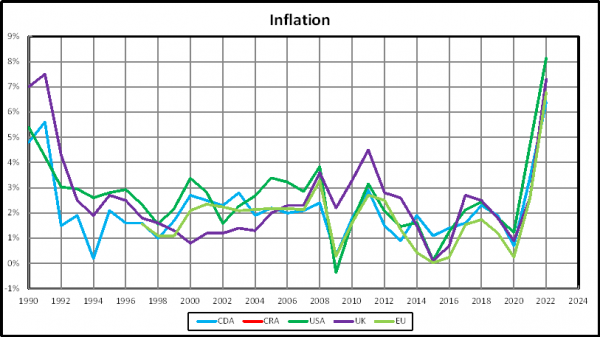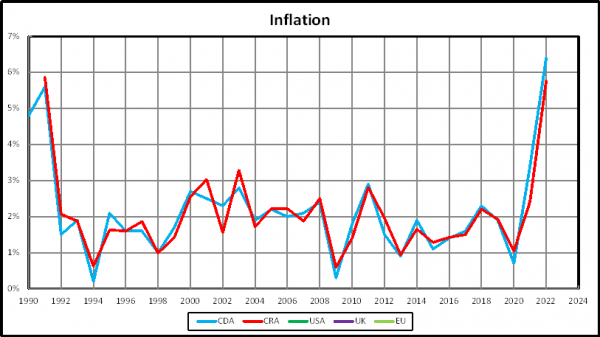 Topic RSS
Topic RSS
2:41 pm
April 6, 2013
 Offline
OfflineBill said
I guess if the rate of change of inflation is accelerating then the gap will grow, plus there's the lag factor. The 2.4% was calculated for the y/e Sept 30/21, far as I know, for what period and from what source was the 4.7 inflation rate?…
The 2.4% inflation rate is correct between the 12 months ending September 2020 and the 12 months ending September 2021.
The rate is based on CPI for the 12 months periods ending each September and not the CPI for two September months.
CPI for October 2019 to September 2020 was 136.7.
CPI for October 2020 to September 2021 was 140.0.
Change is 140/136.7 - 1 = 0.0241 = 2.41%.
In contrast,
CPI for September 2020 was 136.9.
CPI for September 2021 was 142.9.
Change is 142.9/136.9 - 1 = 0.0438 = 4.38%
3:10 pm
September 11, 2013
 Offline
OfflineMaybe this is self-evident to others here but I've no idea what you're saying, Norman1, can you rephrase it differently for me?
You say CPI for Oct/20 - Sept/21 is 140.0. (I thought CPI is at a point in time, not over a period - ?) Then you say CPI for Sept/21 is 142.9, why is that different than 140.0 number?
3:14 pm
February 7, 2019
 Offline
OfflineNorman1 said
Bill said
I guess if the rate of change of inflation is accelerating then the gap will grow, plus there's the lag factor. The 2.4% was calculated for the y/e Sept 30/21, far as I know, for what period and from what source was the 4.7 inflation rate?…
The 2.4% inflation rate is correct between the 12 months ending September 2020 and the 12 months ending September 2021.
The rate is based on CPI for the 12 months periods ending each September and not the CPI for two September months.
CPI for October 2019 to September 2020 was 136.7.
CPI for October 2020 to September 2021 was 140.0.
Change is 140/136.7 - 1 = 0.0241 = 2.41%.In contrast,
CPI for September 2020 was 136.9.
CPI for September 2021 was 142.9.
Change is 142.9/136.9 - 1 = 0.0438 = 4.38%
So to clarify, the Indexation is based on the yearly average and and not the actual inflation?
| CGO |
5:10 pm
April 6, 2013
 Offline
OfflineBill said
…You say CPI for Oct/20 - Sept/21 is 140.0. (I thought CPI is at a point in time, not over a period - ?) Then you say CPI for Sept/21 is 142.9, why is that different than 140.0 number?
The CPI seems to be over a period of time. Make sense as the CPI on any particular day isn't really meaningful.
The CPI basket averaged 140.0 from October 1, 2020 to September 30, 2021.
The CPI basket averaged 142.9 from September 1, 2021 to September 30, 2021.
In effect, the Income Tax Act 117.1 (1) indexes on changes in the cost of 12-month periods and not on changes in the cost of the months of September.
6:48 pm
September 11, 2013
 Offline
OfflineI'm not so sure, I think the CPI is on a certain day, or at least month. It was started in 2002 at $100 and if you bought the same basket in Sept/21 you would pay $142.90 is my understanding. It's probably a bunch of voodoo calculations anyway, e.g. 20 years ago everybody had landline & long distance charges, now everybody pays for smartphone data plan, how do you adjust for the fact we don't spend on what we used to, we spend on stuff we didn't use to? So overall I'm still not sure, but anyway TFSA will go up for 2023.
8:34 pm
April 6, 2013
 Offline
OfflineThe current base period for CPI is not in 2002. The base period "is 2002". That is, January 1, 2002 to December 31, 2002.
Whatever the average price of the basket was for the year 2002 is used to scale future prices so that CPI is 100.0 for that 2002 average price.
CPI of 142.9 for a period means the basket is 142.9/100 = 1.429 times that 2002 average price for that period. It doesn't mean the basket is $142.90 for that period.
Consumer Price Index: FAQ has answers to questions like that.
The Canadian Consumer Price Index Reference Paper has all the technical details.
3:20 am
February 7, 2019
 Offline
Offline5:25 am
February 7, 2019
 Offline
OfflineBill said
Got it, thus the 2.4% indexing. And that makes it pretty much impossible that $7000 will be the 2023 TFSA limit.
Thus far, Oct 2021 to May 2022, Inflation is averaging 5.78%.
If we still average 5.78% Oct 2021 to Sep 2022, we'll end up with a raw TFSA limit of $6556, $6500 when rounded down.
To get to $7000, we'd need a raw TFSA of at least $6750.01 rounded up. For that to happen, we'd need 9.6% Inflation Oct 2021 to Sep 2022. For that to happen, we'd need the annual inflation number reported by Stats Can to be about 17.25% for the next 4 months.
That ain't gonna happen ... 🙂
| CGO |
9:30 am
April 6, 2013
 Offline
OfflineThe indexation factors and raw annual new TFSA contribution rooms have been posted in a separate thread TFSA new contribution room history.
2:05 pm
February 7, 2019
 Offline
OfflineNorman1 said
The indexation factors and raw annual new TFSA contribution rooms have been posted in a separate thread TFSA new contribution room history.
Thanks Norman for your input in all this. The fact that CRA uses annual average inflation instead of annual inflation completed my understanding ...
| CGO |
3:30 pm
April 6, 2013
 Offline
OfflineThe 12-month CPI is described in Statistics Canada's CPI FAQ and actually prescribed by Income Tax Act subsection 117.1(4):
Consumer Price Index
117.1 (4) In this section [117.1], the Consumer Price Index for any 12 month period is the result arrived at by
(a) aggregating the Consumer Price Index for Canada, as published by Statistics Canada under the authority of the Statistics Act, adjusted in such manner as is prescribed, for each month in that period;
(b) dividing the aggregate obtained under paragraph 117.1(4)(a) by twelve; and
(c) rounding the result obtained under paragraph 117.1(4)(b) to the nearest one-thousandth or, where the result obtained is equidistant from two consecutive one-thousandths, to the higher thereof.
11:24 pm
February 7, 2019
 Offline
OfflineBill said
So, for example, when inflation's rising the number given for, say September, is really less than September's current inflation being experienced by buyers, it's closer to the rate happening maybe 4 -8 months ago. Good to know that.
Actually, the CRA averages the previous 12 months of StatCan's monthly annualized inflation numbers to generate an Indexation factor that drives changes in TFSA limits and Income Tax Personal Exemptions, among other things.
It sort of acts as a smoother.
In periods of inflation, the CRA number is lower (e.g. 2014, 2021, 2022).
In periods of deflation, the CRA number is higher (e.g. 2009, 2012, 2015, 2020).
| CGO |
12:16 am
February 7, 2019
 Offline
Offlinecgouimet said
Actually, the CRA averages the previous 12 months of StatCan's monthly annualized inflation numbers to generate an Indexation factor that drives changes in TFSA limits and Income Tax Personal Exemptions, among other things.
It sort of acts as a smoother.
In periods of inflation, the CRA number is lower (e.g. 2014, 2021, 2022).
In periods of deflation, the CRA number is higher (e.g. 2009, 2012, 2015, 2020).
The first graph shows Annual Inflation in Canada, US, UK and EU.

The second graph shows Annual Inflation in Canada and the CRA Annual Index.

| CGO |
6:07 am
February 7, 2019
 Offline
OfflineBill said
Ok, thanks, looks like CRA indexing is close enough. We've not really had deflation, just periods of decreased inflation. I guess if we have deflation OAS, TFSA limits, etc could actually get reduced - ?
I used the term deflation incorrectly. I should have said reduced inflation - the CRA Index does trail Inflation in both directions - on the way up and on the way down ...
Deflation (Negative Inflation)? We've experienced individual months of that in Canada: Jun-Sep 2009 and Apr-May 2020 but not full years. The US, on the other hand, had 8 negative months in 2009 and the 2009 US Annual number was -0.36%
Another piece of data ... Ave Canada Annual Inflation 2002-2021 was 1.87%, Ave CRA Index 2002-2021 was 1.83%. So, not materially different.
I suspect that if we were to experience a Deflation year, Government benefits would not be reduced. My guess, as it probably would be political suicide for any MP or Party voting for that.
| CGO |
 Log In
Log In Register
Register Home
Home


 Facebook
Facebook Twitter
Twitter Email this
Email this




Please write your comments in the forum.